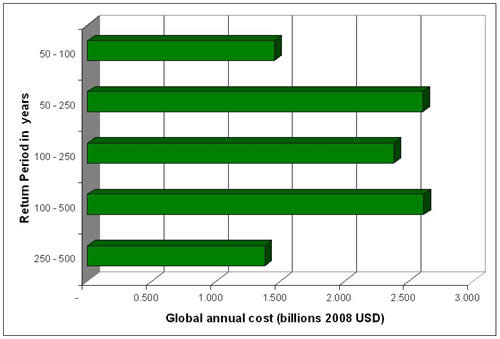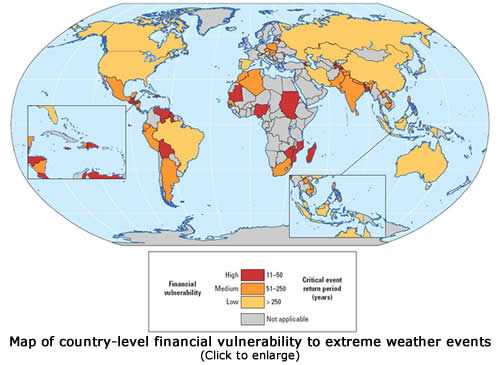The contribution to the World Bank’s World Development Report (WDR) 2010 focused on assessing the costs of extreme weather-related events. There is increased concern about the rising costs from weather extremes. Although largely driven by socioeconomic change, the increase in monetary losses by an order of magnitude within the last four decades cannot entirely be explained away by population or economic growth. A host of estimates for the costs of adaptation, often put together in a kind of “hand-waving“ methodology, have been suggested, yet the robustness and underlying basis has often been difficult to verify.
For a subset of the adaptation challenge, changes in weather variability and extremes, we conducted an assessment of today’s costs of financially managing public sector risks. Current climate variability and associated risks can be interpreted as a baseline for future changes, which are currently associated with massive uncertainties.
National governments are key actors in managing climate variability and change, yet, many highly exposed developing countries, faced with exhausted tax bases, high levels of indebtedness and limited donor assistance have been unable to raise sufficient and timely capital to replace or repair damaged assets and restore livelihoods following major disasters exacerbating the impacts of disaster shocks on poverty and development.
We assessed countries’ financial vulnerability, which we operationalize as the public sector’s ability to pay for relief to the affected population, support the reconstruction of affected assets and infrastructure and aid the recovery process. We define a resource gap asthe net loss associated with a disaster event after all possible ex-post and ex-ante public sector financing sources have been exhausted.
We find a number of countries highly financially vulnerable and the majority of the disaster prone countries of our sample experience such a disaster financing problem below a 50 year event. For example the map (map 2.5 from chapter 2, page 20 of the WDR) shows the degree to which countries are financially vulnerable to floods and storms. In countries shaded dark red a severe weather event that would exceed the public sector’s financial ability to restore damaged infrastructure and continue with development as planned is expected about once every 11 to 50 years (an annual probability of about 2–10 percent). The high financial vulnerability of small economies underscores the need for financial contingency planning to increase governments’ resilience against future disasters.
Note: Our results as shown on map 2.5 of the World Development Report 2010, chapter 2, p.20. Only the 74 most disaster-prone countries that experienced direct losses of at least 1 percent of GDP due to floods, storms, and droughts during the past 30 years were included in the analysis.
For financially vulnerable countries, we see three main implications: (i) In such countries, efforts to reduce risk need to be seriously stepped up in order to reduce the serious human and financial burdens to the affected population, business and fiscal stance; (ii) contrary to the Arrow Lind theorem (1970), there are cases of country-level risk aversion; this means, that disaster risks borne by a government cannot be absorbed without major difficulty. Risk aversion calls for deliberating to prefinance losses and relief expenditure by way of risk financing instruments, such as calamity funds, regional insurance pools or contingent credit arrangements; (iii) without exception, all financially vulnerable countries, due to their development status, are very unlikely to be able to purchase pre-disaster risk financing instruments themselves in order to reduce their financial vulnerability and may require technical and financial assistance from the donor community.
We conducted estimates that may inform decisions pertaining to a “climate insurance fund,” which would fund “high level” country losses that exceed the ability of any given country to pay in the case of an extreme event.
How much money would such a pool require to fill the funding gap post-disaster for all disaster prone countries? The figure below shows the funding requirement for different layers of disaster event recurrence.

If for example, funding would be set aside to cover resource gaps for more frequent events with a return period of 50 to the 100 year events, then about 1.4 billion USD would be required annually. Covering more infrequent losses as well (such as up to a 250 year event), would mean that more funding would be required, up to 2.6 billion USD. Also, other layers, such as 100-250 year resource gap layers, could be considered to be covered with associated funding requirements. The estimates may seem low, but bundling many risks in a portfolio makes use of the diversification effect and thus results in lower funding requirements. Furthermore, the estimates relate to risk layers of public sector risks only, and, finally, we took the simplifying assumption that risks are independent, and we calculated average losses over the portfolio. Thus, the estimate of the funding requirements have to be considered a lower bound.
IIASA Researchers:
Reinhard Mechler
Stefan Hochrainer
Georg Pflug
Responsible for this page: Jun Watabe
Last updated:
24 Sep 2009
Phone: (+43 2236) 807 0
Copyright © 2009-2011 IIASA
